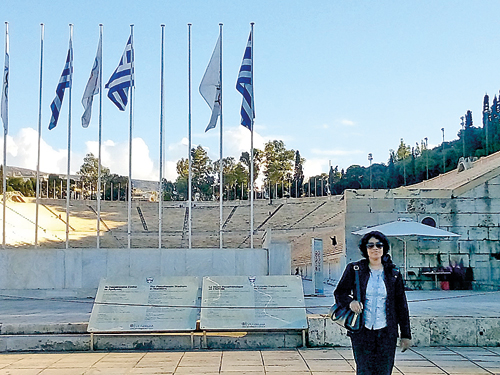At the venue of the first modern Olympics Games…

At the entrance of the Panathenaic Stadium
The Olympic spirit is once again in the air. Games of the XXXII Olympiad is opening in Tokyo on 23rd July 2021. The Panathenaic Stadium (also known as Kallimarmaro) in Athens Greece, was the venue of the first modern Olympic Games. I was a visitor to this historic place a few years ago and the memories are still afresh.
Located at the heart of Athens in the vicinity of the Greek Parliament building, the National Gardens, the Temple of Olympian Zeus and theZappeion Exhibition Hall, this marble built stadium is among the most attractive sites of the city. Having climbed to the upper tier of the stadium, one can get a terrific view of the Acropolis and Parthenon, another famous destination for travelers to Athens.
The stadium has a long history that dates back to the 6th century BC. Initially, the venue was a racecourse that hosted the religious and athletic festival in honor of the goddess Athena. Name of the festival was “Panathenaic Games” and was held once in every four years. As formal seating arrangements were not available at that time, the spectators had to sit and watch from the hillside. Two hundred years on, formal seating was built by Lykourgosby arranging tiers of stone benches around the 204 m -long and 34 m -wide track. In the 2nd century AD, Herodes Atticus reconstructed the stadium completely out of white Pentelic marble obtained from Mt Penteli; the same type of marbles used to build the Acropolis and Parthenon. He transformed the stadium to a horseshoe shape from its original rectangular shape,while increasing the seating capacity to 50,000. In addition to the athletic competitions, the stadium was believed to be a venue for gladiator fights. However, over the centuries; particularly upon the fall of the Roman Empire, the stadium was abandoned and fell into ruin. The derelict marbles were incorporated into local constructions and the site was reduced wheat field.
 Several centuries later in the 19th century, the archaeological excavations dawned a new life to this historical site. The stadium was refurbished and it hosted a series of athletic events called “Zappas Olympics” (an early attempt to revive the ancient Olympic Games) under the sponsorship of EvangelisZappas in 1870 and 1875. In 1894, Baron Pierre de Coubertin established the International Olympic Committee (IOC) and presented the idea of organizing internationally rotating Olympic Games that would occur in every four years. DemetriosVikelas, the first president of the IOC suggested that the first modern Olympics Games should be held in the Greek Capital in 1896. Thus the stadium underwent the second refurbishment, once again with white Pentelic marble in preparation to host the first modern Olympic Games. Refurbishment work was sponsored by George Averoff. As a tribute to his generosity, a marble portrait was erected near the entrance to the stadium.
Several centuries later in the 19th century, the archaeological excavations dawned a new life to this historical site. The stadium was refurbished and it hosted a series of athletic events called “Zappas Olympics” (an early attempt to revive the ancient Olympic Games) under the sponsorship of EvangelisZappas in 1870 and 1875. In 1894, Baron Pierre de Coubertin established the International Olympic Committee (IOC) and presented the idea of organizing internationally rotating Olympic Games that would occur in every four years. DemetriosVikelas, the first president of the IOC suggested that the first modern Olympics Games should be held in the Greek Capital in 1896. Thus the stadium underwent the second refurbishment, once again with white Pentelic marble in preparation to host the first modern Olympic Games. Refurbishment work was sponsored by George Averoff. As a tribute to his generosity, a marble portrait was erected near the entrance to the stadium.
The Panathenaic Stadium was the venue for the opening and closing ceremonies of the 1896 Olympics. In addition, athletics, gymnastics, weightlifting and wrestling events of the Olympics were also held at this location. The stadium then hosted diverse cultural, ceremonial and sporting events throughout the 20th century. Once again the stadium was used as a venue for the 2004 Summer Olympics in Athens. It hosted the archery events and the finishing line for the men’s and women’s marathon. In every November it holds the finishing line for the annual Authentic Athens Marathon race, runs from the city of Marathon to Athens.
It’s a tradition that the Olympic flame is ignited at the Temple of Hera in Olympia several months before the opening ceremony of an Olympic Games. This flame travels through Greece over the cause of several weeks. At its final stop, the Panathenaic Stadium,theflame is officially handed over to the host country.
The Panathenaic Stadium is the only stadium in the world that is entirely made of marble. At present, the stadium can provide seating capacity for about 60 000 spectators. It has 47 rows of seats that are divided into two zones (lower tier: 24 rows and upper tier: 23 rows) through a corridor. The track with a length of 191 m and a width of 34 m features a comfortable black rubber surface. The Panathenaic Stadium was depicted on the Olympic medals awarded in Athens in 2004, in Beijing in 2008, in London in 2012 and Rio de Janeiro in 2016.
Spending 5euros for the entrance ticket to this glamorous stadium was certainly a well spent for me. An audio guide device was provided at the entrance and the audio tour narrated the history of the stadium evoking the grandeur of ancient Athens that was surrounding me. I grabbed the opportunity to run on the historical running track in the pleasant late Autumn breeze. I felt honored to stand on the Olympic winners’ podium, although I had never won a race!! The museum located on the underground features the posters and the Olympic torches of every Olympic Game held from 1896 to this date. The museum tour was a truly enjoyable and educational experience.
The legendary Panathenaic Stadium is
an icon of Athenian history and its culture that notraveler should miss out during a trip to Athens.


